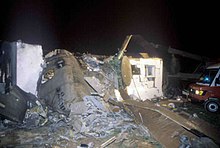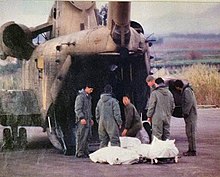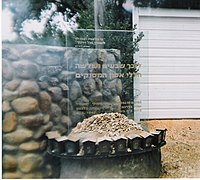 The remains of one of the crashed helicopters The remains of one of the crashed helicopters | |
| Accident | |
|---|---|
| Date | February 4, 1997 (1997-02-04) |
| Summary | Mid-air collision |
| Site | She'ar Yashuv in northern Israel 33°13′20″N 35°38′28″E / 33.22222°N 35.64111°E / 33.22222; 35.64111 |
| Total fatalities | 73 |
| Total survivors | 0 |
| First aircraft | |
| Type | Sikorsky S-65C-3 Yas'ur 2000 |
| Operator | |
| Registration | 357 |
| Fatalities | 37 |
| Survivors | 0 |
| Second aircraft | |
| Type | Sikorsky S-65C-3 Yas'ur 2000 |
| Operator | |
| Registration | 903 |
| Fatalities | 36 |
| Survivors | 0 |
The 1997 Israeli helicopter disaster (Hebrew: אסון המסוקים, romanized: Ason HaMasokim, lit. ''Disaster of the Helicopters'') occurred on February 4, 1997, when two Israeli Air Force transport helicopters ferrying Israeli soldiers into Israel's security zone in southern Lebanon collided in mid-air, killing all 73 Israeli military personnel on board. The crash brought about widespread national mourning and is considered a leading factor in Israel's decision to withdraw from southern Lebanon in 2000.
Background


Following the 1982 Lebanon War, Israel had withdrawn to a "security zone" in southern Lebanon, where it faced an insurgency by Hezbollah and other Lebanese groups.
Israel had originally moved troops by ground, but this policy was changed as the threat of roadside bombs increased. As a result, Israel increasingly began ferrying soldiers by air into southern Lebanon.
The crash
| This section needs additional citations for verification. Please help improve this article by adding citations to reliable sources in this section. Unsourced material may be challenged and removed. Find sources: "1997 Israeli helicopter disaster" – news · newspapers · books · scholar · JSTOR (February 2018) (Learn how and when to remove this message) |
Two Sikorsky S-65C-3 Yas'ur 2000 helicopters, 357 and 903, were assigned on a mission to fly Israeli soldiers and munitions into southern Lebanon, originally scheduled for February 3, but postponed a day due to bad weather conditions. On February 4, the weather conditions were still poor for flying due to fog. In the afternoon visibility improved, and the mission was allowed to go forward.
The two helicopters took off from Tel Nof Airbase and flew to Rosh Pina Airport, from where they collected the troops. One helicopter, numbered 903, was designated to fly to the "Pumpkin" Outpost, east of Nabatiyeh, and had four crew and 32 passengers on board. The second helicopter, 357, was to fly to an Israeli position at Beaufort Castle, and had four crew and 33 passengers on board.
At 6:48 PM, after final approval was given and the soldiers had been briefed, both helicopters were cleared to take off. A minute after takeoff, the captain of the helicopter 903 requested permission from air traffic control to cross the border into Lebanon. Permission was delayed, and the helicopters ended up hovering until 6:56 PM, when a controller confirmed that they had permission to cross. Three minutes later, the helicopters disappeared from radar.
The two helicopters collided over moshav She'ar Yashuv in northern Israel. An Israeli investigation concluded that the rotor of helicopter 357 struck the tail of helicopter 903. Helicopter 357 immediately crashed, while the crew of helicopter 903 attempted to take control of it, but failed, and it crashed as well. According to one witness who observed the event from the ground, "Two helicopters passed over my house without their lights on. Then there was a flash. One fell straight away and the other wavered for half a kilometre... then it also exploded." One of the helicopters crashed in a fireball directly onto She'ar Yashuv, setting an empty bungalow on fire, while the other crashed into the cemetery of kibbutz Dafna a few hundred metres away.
Fires, fueled by jet fuel from the helicopters, broke out on the ground, and munitions that had been stored aboard the helicopters cooked off and set off a series of explosions. Some witnesses claimed they could hear faint cries coming from the wreckage, but they could not get close to them because of the explosions, and that the cries ceased after the explosions. All 73 soldiers on the helicopters were killed. There were no casualties on the ground. One witness claimed to have seen a soldier thrown from a helicopter who initially still had a pulse, but died soon after.
Following the crash, soldiers, firefighters, and rescue crews raced to the scene. Magen David Adom rushed twenty ambulances and two mobile intensive care units to the scene. However, it soon became clear there were no survivors. Fearing that additional ammunition could explode, the IDF cordoned off all communities in the area, declaring them closed military zones, shut down all local roads, and sent in bomb squads to clear the area of explosives. This created massive traffic jams and temporarily prevented hundreds of people from reaching their homes.
Rescue crews recovered bodies and pieces of equipment from the scene, and some of the dead were found still strapped into their seats. The bodies were taken to a makeshift morgue set up on a nearby military base for identification. The IDF censored news of the crash for more than two hours to enable the families of the victims to be informed, but swift identification proved impossible. All of the bodies had been recovered by the morning of February 5.
Aftermath


The crash was the deadliest air disaster in Israeli history. A wave of national mourning swept Israel. According to Joshua L. Gleis, "In a close-knit country where nearly everyone joins the military, a huge portion of the nation's population knew at least one of the soldiers killed in the crash."
February 6 was declared an official day of mourning. Flags were flown at half-mast, restaurants and cinemas closed, the Knesset observed a minute of silence, and the names of the dead were read out at the beginning of every news bulletin on television and radio. Thousands of Israelis went to pray at the Western Wall and assemblies were held at schools nationwide.
The funerals began taking place on February 5. Prime Minister Benjamin Netanyahu and President Ezer Weizman attended funerals and visited the grieving families.
Israeli Defense Minister Yitzhak Mordechai appointed a commission of inquiry headed by David Ivry to investigate the cause of the collision. The commission recommended that the commander of the helicopters' squadron be dismissed and barred from any future command positions, the commander of Tel Nof Airbase and the deputy commander of the squadron, who had briefed the pilots before their mission, be reprimanded, and that the officer in charge of Rosh Pina Airport be dismissed from his position and barred from serving in any command position for three years.
In its recommendations to prevent future accidents, the commission recommended that the number of flights per pilot be reduced, that clear procedures be established regarding the turning off of lights when crossing borders, that a lead helicopter be established when two fly together, that squadrons operate under the same procedures, and that helicopters fly alone during any night flights into southern Lebanon. It recommended that the Israeli Air Force install black boxes in its helicopters.
The disaster sparked renewed debate about Israel's occupation of southern Lebanon. Later that year, the Four Mothers, an anti-war protest movement dedicated to pressing for an Israeli withdrawal from southern Lebanon, was founded. This event is seen as a catalyst for Israel's withdrawal from the security zone in Lebanon in 2000.
Memorials

A memorial to the 73 dead IDF soldiers was created near the crash site of one helicopter next to the cemetery of kibbutz Dafna. It was inaugurated in 2008. The memorial consists of a number of elements, the most visible being 73 stones erected around a round pool to which water is directed through a channel. The 73 names are written on black blocks placed under the water of the pool. A Bible verse from Job 41:17 is inscribed. The monument was designed by architect Shlomit Shlomo, landscape architects Haim Cohen and Gilad Sharon, sculptor Rami Feldstein; sculptor Dani Karavan acted as an adviser for the project.
In moshav She'ar Yashuv, where the second helicopter crashed, another monument was erected. On the southeast edge of the moshav, the "Forest of the Fallen" was planted to memorize the dead. The forest has 73 trees, one for each victim of the crash.
There are numerous other memorial monuments throughout Israel commemorating the disaster. In addition, there exist memorials for individual soldiers in the places where they lived.
On February 15, 2017, a memorial service was held in Kibbutz Dafna to mark the 20th anniversary of the disaster. Bereaved families of the victims attended, as well as President Reuven Rivlin, Defense Minister Avigdor Lieberman, and IDF Chief of Staff Gadi Eizenkot.
-
 Portrait photos of all 73 victims
Portrait photos of all 73 victims
-
Memorial in Migdal HaEmek
-
 Memorial in She'ar Yashuv
Memorial in She'ar Yashuv
See also
References
- Eisenberg, Laura Zittrain (September 1997). "Israel's Lebanon Policy". Middle East Review of International Affairs. 1 (3). Archived from the original on July 21, 2011. Retrieved February 23, 2011.
- "מרקיע שחקים - עודכן! התנגשות יסעורים 357 ו-903 (אסון שאר ישוב)" [Skyscraper - Updated! Storm Clash 357 and 903 (Disaster in the Rest of the City)] (in Hebrew). Archived from the original on January 25, 2017. Retrieved February 13, 2017.
- ^ Miller, Marjorie (February 5, 1997). "Israeli Helicopters Collide in Midair; 73 Soldiers Killed". Los Angeles Times. ISSN 0458-3035. Retrieved February 2, 2018.
- Amir, Noam; Hashavua, Maariv (February 5, 2016). "Israel remembers 73 soldiers who died in helicopter disaster 19 years ago". The Jerusalem Post. Retrieved February 2, 2018.
- Miller, Majorie (February 5, 1997). "Israeli Helicopters Collide in Midair; 73 Soldiers Killed". Los Angeles Times.
- ^ "Israel mourns soldiers killed in air crash". CNN. February 5, 1997. Retrieved February 2, 2018.
- ^ Prince-Gibson, Eetta (February 5, 1997). "73 ISRAELI TROOPS DIE IN COPTER COLLISION". Washington Post. ISSN 0190-8286. Retrieved February 2, 2018.
- "Israel - Aftermath of helicopter crash". Associated Press. February 5, 1997. Retrieved February 2, 2018.
- "Military helicopters collide in Israel, killing scores". CNN. February 4, 1997. Retrieved June 11, 2006.
- Gleis, Joshua L: Withdrawing Under Fire: Lessons Learned from Islamist Insurgencies, P. 104
- ^ "Israel buries helicopter crash dead". February 6, 1997. Archived from the original on May 1, 2022. Retrieved February 13, 2017.
- "Fatal helicopter crash inquiry recommends disciplinary action". Jewish Telegraphic Agency. June 5, 1997. Retrieved August 6, 2020.
- "Fatal helicopter crash inquiry recommends disciplinary action". Jewish Telegraphic Agency. June 5, 1997. Retrieved August 6, 2020.
- Harris, Rachel S.; Omer-Sherman, Ranen, eds. (2012). Narratives of Dissent: War in Contemporary Israeli Arts and Culture. Detroit: Wayne State University Press. pp. 49–55. ISBN 9780814338032. Retrieved January 30, 2016.
- "Helicopter Crash Memorial, Israel - Israel and You". January 20, 2014. Retrieved February 13, 2017.
- Ashkenazi, Eli (August 1, 2013). "Israel Police to Investigate Desecration of IDF Helicopter Accident Memorial". Haaretz. Retrieved February 13, 2017.
- "20 years on, Israel marks helicopter disaster that claimed 73 soldiers". Times of Israel. February 15, 2017. Retrieved February 2, 2018.
External links
- "Military helicopters collide in Israel, killing scores", CNN, 4 February 1997. Accessed 11 June 2006.
- " The Israeli Helicopter Crash- Reactions in Lebanon", News at Lebanon, 5 February 1997. Accessed 11 June 2006.
- Helicopter disaster, Exhibition in the IDF&defense establishment archives Archived August 31, 2020, at the Wayback Machine
- Segal, Naomi. "Pilot error may because of horrific helicopter crash", Jewish Telegraphic Agency, 14 February 1997. Accessed 11 June 2006.
- Segal, Naomi. "Discipline recommended in copter crash that killed 73", Jewish Telegraphic Agency, 25 April 1997. Accessed 11 June 2006.
| Aviation accidents and incidents in 1997 (1997) | |
|---|---|
| Jan 9 Comair Flight 3272Feb 4 Israeli helicopter disasterMar 18 Stavropolskaya AA Flight 1023Apr 19 Merpati Nusantara Airlines Flight 106May 8 China Southern Airlines Flight 3456Jul 17 Sempati Air Flight 304Jul 30 Air Littoral Flight 701AJul 31 FedEx Express Flight 14Aug 6 Korean Air Flight 801Aug 7 Fine Air Flight 101Aug 10 Formosa Airlines Flight 7601Sep 3 Vietnam Airlines Flight 815Sep 6 Royal Brunei Airlines Flight 839Sep 8 Helikopter Service Flight 451Sep 13 Namibia mid-air collisionSep 26 Garuda Indonesia Flight 152Oct 10 Austral Líneas Aéreas Flight 2553Oct 12 John Denver plane crashNov 5 Virgin Atlantic Flight 024Dec 6 Russian Air Force Antonov An-124Dec 15 Tajikistan Airlines Flight 3183Dec 16 Air Canada Flight 646Dec 17 Aerosvit Flight 241Dec 19 SilkAir Flight 185Dec 28 United Airlines Flight 826 | |
| 1996 ◄ ► 1998 |
| Aviation accidents and incidents in Israel | |
|---|---|
|
- 1997 in Israel
- Accidents and incidents involving the Sikorsky CH-53 Sea Stallion
- Aviation accidents and incidents in 1997
- Aviation accidents and incidents in Israel
- Israeli Air Force
- Israel Defense Forces disasters
- Mid-air collisions
- Mid-air collisions involving military aircraft
- February 1997 events in Asia
- South Lebanon conflict (1985–2000)
- 1997 disasters in Israel